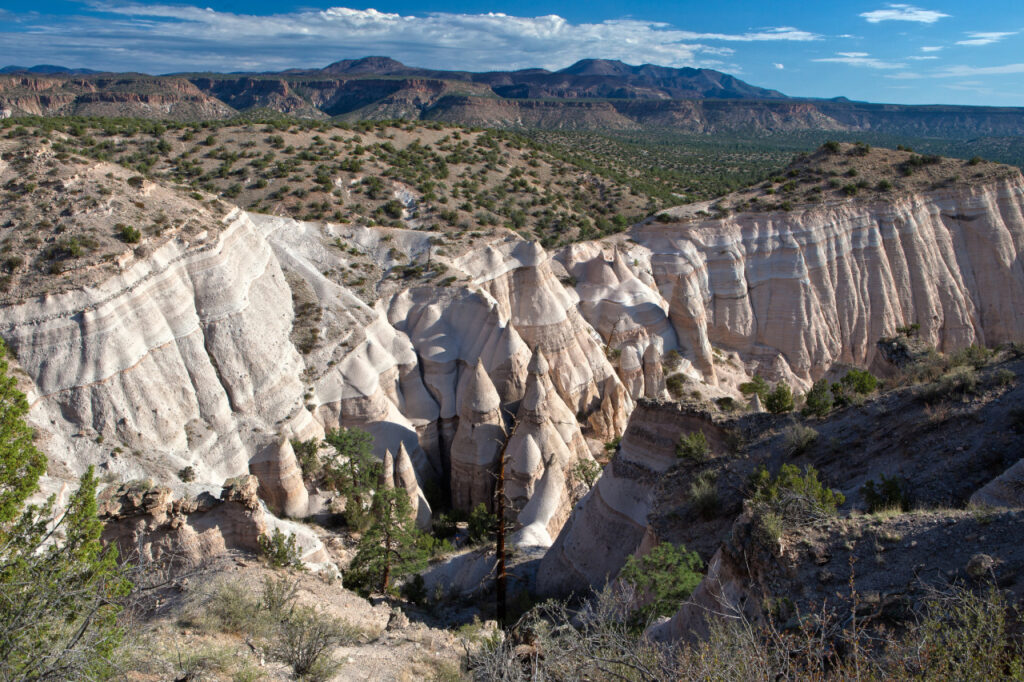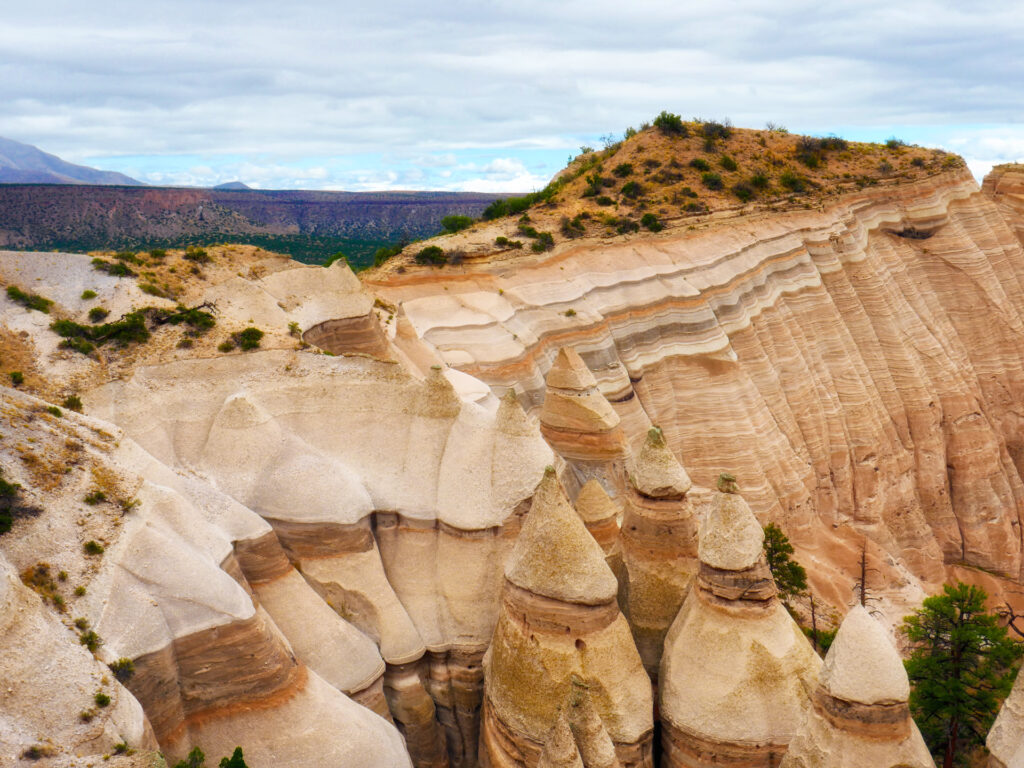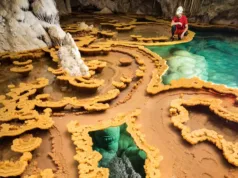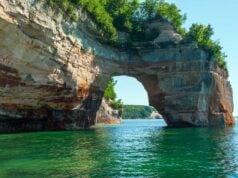Kasha-Katuwe Tent Rocks National Monument is a remarkable outdoor destination in the United States, known for its unique geological formations. These formations, called hoodoos, are cone-shaped tent rock structures that result from volcanic eruptions that occurred 6 to 7 million years ago. The layers of pumice, ash, and tuff from these eruptions have been eroded into the stunning shapes you see today, with some of the tent rocks topped with boulder caps, which protect the softer pumice and tuff below.


Location and Accessibility Kasha-Katuwe Tent Rocks is located in north-central New Mexico, about 40 miles southwest of Santa Fe. The nearest major town is Cochiti, and it is situated on the Pajarito Plateau on the eastern slopes of the Jemez Mountains. This national monument is accessible via NM State Road 22 and then onto a tribal road that leads to the monument area. The site is managed by the Bureau of Land Management in cooperation with the Pueblo de Cochiti.
The monument offers several hiking trails, including the Cave Loop and the more challenging Slot Canyon Trail, which provide up-close views of the tent rocks and the opportunity to walk through a narrow canyon. The area is typically open to visitors year-round, but hours and accessibility can vary depending on weather conditions and other factors, so it’s always a good idea to check the official BLM site or contact the monument’s visitor center for current information before planning your visit.
Geology and Formation of Kasha-Katuwe Tent Rocks

Geological History The geological history of Kasha-Katuwe Tent Rocks is deeply intertwined with the volcanic activity that shaped much of New Mexico’s landscape. Approximately 6 to 7 million years ago, during the Pliocene epoch, the region experienced explosive volcanic eruptions. These eruptions expelled vast amounts of pumice, ash, and tuff, which later solidified into the rock formations visible today.
Volcanic Activity and Rock Formation The specific rock formations at Kasha-Katuwe Tent Rocks, primarily composed of pumice, ash, and tuff, owe their existence to these volcanic eruptions. Over millennia, the deposited materials compacted and solidified. The region’s unique geological structure was further shaped by erosion. The softer pumice and ash were more susceptible to wind and water erosion, leading to the creation of the tent rock formations. These rocks are protected at their tops by harder, less erodible boulder caps, which have slowed the erosion process and given the rocks their distinctive, tent-like appearance.
Unique Features
- Conical Rock Formations: The most striking features of Kasha-Katuwe are the tent-like conical rock formations. These formations range in height from a few feet to approximately 90 feet. The conical shapes are a direct result of differential erosion rates, where the softer sedimentary base erodes faster than the caprocks.
- Slot Canyons: Another fascinating feature at Kasha-Katuwe Tent Rocks is the presence of slot canyons. These narrow canyons were carved out by water flow that eroded the softer rock away, leaving behind narrow passages between towering walls of rock. The Slot Canyon Trail allows visitors to walk directly through these impressive formations, providing an intimate experience of this dynamic landscape.
- Cave Loop: Along the Cave Loop trail, visitors can observe small cave-like formations which have been hollowed out from the rock walls. These were formed by the same processes of erosion that created the tent rocks and slot canyons, further showcasing the diverse erosive powers at work in this landscape.
The combination of volcanic activity and subsequent erosion has created a geological landscape at Kasha-Katuwe Tent Rocks that is not only scientifically fascinating but also visually stunning, attracting geologists, hikers, and nature lovers alike.
Visitor Information

Visiting Kasha-Katuwe Tent Rocks National Monument provides a unique opportunity to explore its distinctive geological features and enjoy the natural beauty of the area. Here’s some useful information to help you plan your visit:
Operating Hours and Seasons Kasha-Katuwe Tent Rocks is typically open year-round, but operating hours can vary. It is generally open from 8:00 AM to 5:00 PM, but these hours can be subject to change depending on the season and weather conditions. It’s important to check the latest information from the Bureau of Land Management (BLM) or the monument’s official website before your visit.
Entrance Fees There is a nominal entrance fee for accessing Kasha-Katuwe Tent Rocks. Fees are per vehicle and are used to maintain and manage the park facilities. Check the official site for the most current fee structure.
Trails and Hiking The monument offers several hiking trails that cater to different fitness levels:
- Cave Loop Trail: An easy 1.2-mile loop that provides views of the tent rocks, cave formations, and the surrounding scenery.
- Slot Canyon Trail: A more challenging 3-mile round trip that goes through a narrow canyon and ascends to a lookout point with panoramic views. This trail is more strenuous and requires some climbing on rocky steps.
- Veterans Memorial Trail: A 1-mile loop that is wheelchair accessible and offers great views with less physical challenge.
Facilities The park provides basic facilities, including a parking area, restrooms, and picnic areas. There are no camping facilities available on-site, and lodging needs to be arranged in nearby towns or in Santa Fe.
Rules and Regulations
- Pets are not allowed on the trails.
- It’s advisable to carry plenty of water, especially during summer months, as the trails offer minimal shade.
- Visitors are encouraged to stay on designated trails to protect the fragile desert environment and the unique geological formations.
Accessibility The Veterans Memorial Trail is wheelchair accessible, providing an opportunity for visitors with mobility issues to enjoy the park. Other trails involve uneven terrain and may not be suitable for all visitors.
Getting There Kasha-Katuwe Tent Rocks is located about 40 miles southwest of Santa Fe, New Mexico. The nearest towns are Cochiti and Pena Blanca. Access is typically via NM-22, following signage to the monument area.
Visiting Kasha-Katuwe Tent Rocks is a great way to experience the unique natural beauty of New Mexico and learn about the area’s fascinating geological history.




































